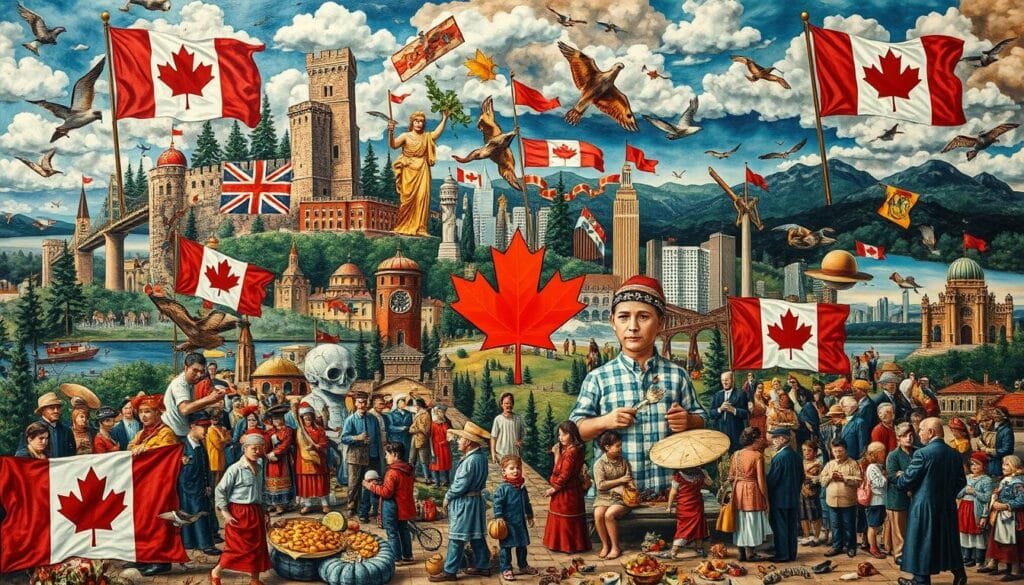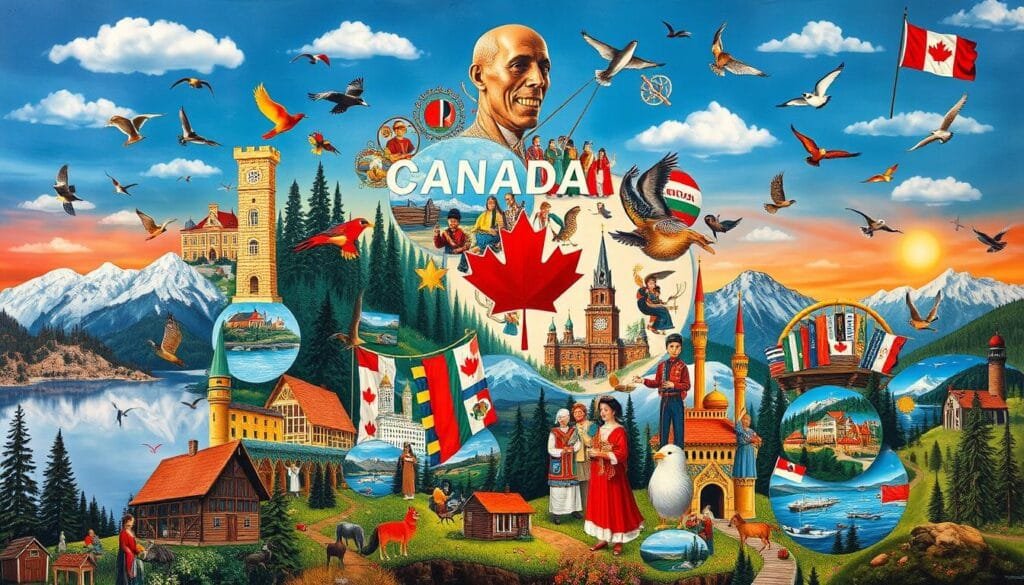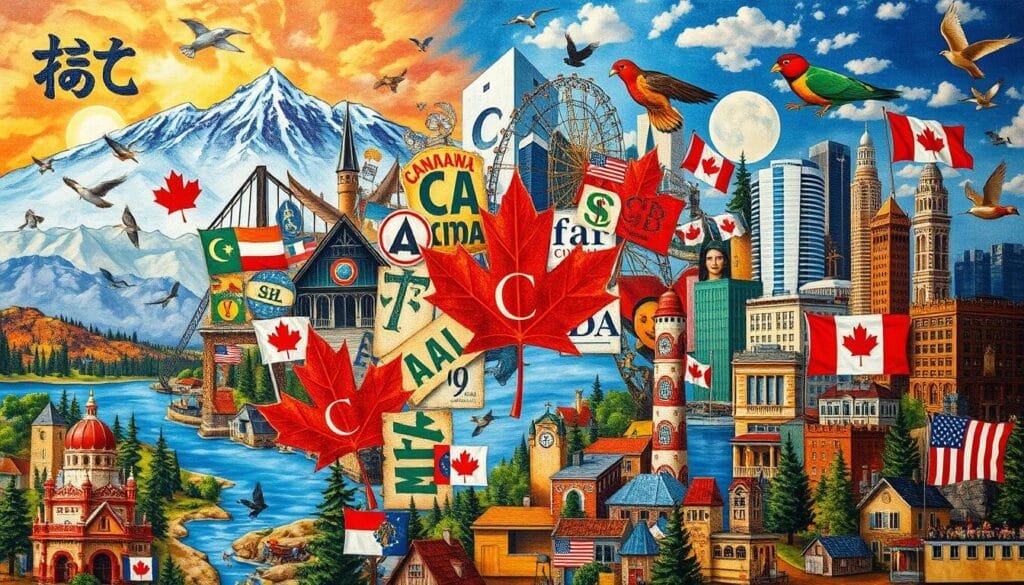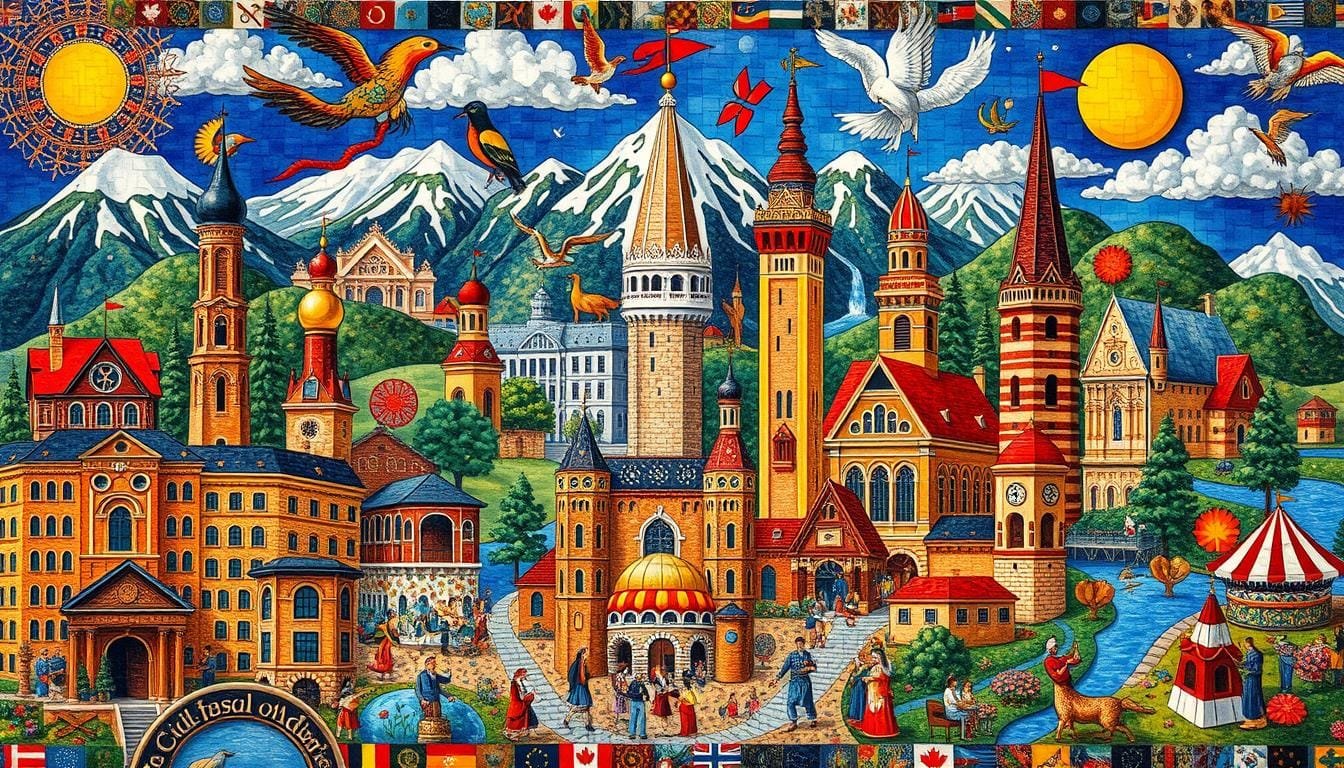Have you thought about how Canada blends so many cultures into one identity? This country, influenced by British and French history, and now rich in multiculturalism, is a great example of cultural mixing. But, is it really as smooth as we think?
To really understand, we must look past the perfect image of Canada as a multicultural haven. Consider the Multiculturalism Policy of 1971 and the 1988 Multiculturalism Act. These laws made cultural diversity a key part of Canada’s identity. Yet, with today’s varied populations, merging cultures comes with both chances and challenges.
Statistics show tough truths: jobless rates for visible minorities are higher, by 1.5 to 2 times, compared to Canadian-born people. And, systemic racism remains a problem. Also, Quebec’s French Language Charter shows how hard it is to juggle multiculturalism and regional identities.
Over half of the immigrants feel pushed to fit in. This feeling of being out of place points to a big issue. It raises a critical question – are we achieving true integration or just living side-by-side?
Key Takeaways
- Canada’s Multiculturalism Act of 1988 underscores the nation’s commitment to cultural diversity.
- Visible minorities face unemployment rates 1.5 to 2 times higher than their Canadian-born counterparts.
- Quebec’s emphasis on French complicates broader multicultural policies.
- Systemic racism presents persistent challenges for Indigenous peoples, Black Canadians, and other racial minorities.
- Over 50% of immigrants feel pressured to assimilate, indicating significant cultural integration challenges.
The Concept of Multiculturalism in Canada
Canadian multiculturalism has a rich history, starting over 40 years ago. It has grown from early immigrant times to significant changes in the 1970s. This section dives into these changes, focusing on government actions and demographic shifts.
Historical Overview
The official policy of multiculturalism in Canada began in 1971, thanks to Prime Minister Pierre Trudeau. This marked a key shift, valuing the diversity and roles of different ethnic groups. The policy has changed over time, reflecting shifts in population and values, as seen in the Wikipedia entry on Multiculturalism in Canada. It moved Canada from a bicultural to a multicultural national identity.
Government Policies
Canada’s government plays a big role in keeping the country’s cultural diversity. The Canadian Multiculturalism Act of 1988 highlights this dedication. The Canadian Charter of Rights and Freedoms backs these efforts, letting citizens keep their cultures while blending into Canadian life. Policy changes, like those in 2014, show efforts to balance integration with preservation.
Current Demographics
Canadian multiculturalism is shown through demographic changes. For example, Brampton’s population boomed from 234,445 in 1991 to 521,315 in 2011. That’s a 122% increase. During the same time, the white population in Brampton dropped by 12%, even as the city grew by 60%. These numbers highlight how immigration policies shape Canadian cities. Despite these shifts, most Canadians value diversity and are proud of the country’s multicultural nature.
| Year | Brampton Population | White Canadian Population |
|---|---|---|
| 1991 | 234,445 | 192,400 |
| 2011 | 521,315 | 169,230 |
Economic Integration and Cultural Acculturation
Integrating into Canada culturally and economically benefits both immigrants and the country. We’ll explore the economic effects of acculturation, how winter sports aid in cultural integration, and Canada’s performance against other countries.
Economic Impact of Acculturation
In 2018, immigration fueled 82% of Canada’s population growth, says Statistics Canada. Immigrants made up 22% of the population, a peak since 1921. This influx helps the workforce, fills job gaps, and grows the economy. Rural employers often prefer hiring immigrants, valuing their economic contributions.
Canada also has settlement organizations aiding immigrants (Canada Council for Refugees, 2000). These groups boost job chances and economic gains for both sides.
Employed immigrants tend to adapt well to Canada, linking job satisfaction with social unity (Richmond, 1974; Starr and Roberts, 1982).
The Role of Winter Sports
Winter sports, like ice hockey, are key in cultural integration. These activities help newcomers connect with locals and build networks. Engaging in beloved national sports can lead to better job integration too.
Winter sports also support physical and mental health through community activities. They make immigrants feel welcome, easing their adaptability.
Comparison with Other Nations
Canada excels among G7 nations in immigration-driven population growth. In 2018, it welcomed 321,035 immigrants, boosting the economy (Statistics Canada, 2019). The UK, however, struggled with economic integration despite a 53% rise in ethnic minorities from 1991 to 2001, due to cultural and support differences.
A closer look at the table below highlights Canada’s stance:
| Country | Immigrant Population Increase (%) | Economic Benefits |
|---|---|---|
| Canada | 82% (2018) | High workforce integration, substantial economic growth, better support systems |
| United Kingdom | 53% (1991-2001) | Moderate workforce integration, slower economic benefits |
| United States | Varies | High workforce participation but unequal economic benefits |
This comparison shows Canada’s economic acculturation benefits as a model for other nations. Combining sports for cultural integration with supportive immigrant systems leads to thriving economic integration.
Does Canada Have a Hard Time Merging Cultures?
Canada faces many challenges when integrating cultures. Issues come from systemic problems that prevent cultures from blending. One big issue is racial discrimination, which sets up barriers to cultural merger in Canada. This can segregate communities and block the mixing of cultural values and traditions.

Economic differences make things harder. Immigrants often struggle to find good jobs. This leads to economic gaps that hurt efforts to bring cultures together. Canada tries to support its cultural industries with money and tax breaks. But, global trade rules and globalization challenge these efforts.
There are also rules about Canadian content in media. They aim to protect local culture but struggle against international media. This makes it hard to keep Canadian culture visible and important.
Big international companies add to the challenge. Canada’s policies must evolve to deal with issues from wider trade agreements. There’s a debate if cultural items should be treated differently in trade compared to other goods.
Technology changes how Canadians access cultural products. The shift to digital is challenging for Canada’s cultural industries in a global, tech market. There’s worry about whether these industries can survive.
To improve challenges in Canadian cultural integration, some suggest new international agreements. These would focus on cultural and linguistic diversity. The Cultural Industries Sectoral Advisory Group on International Trade (SAGIT) pushes for policies that recognize the special value of cultural goods.
Cultural stories and images play a key role in society, but views on them vary. It’s important to find a balanced approach to cultural integration. Adapting to global influences is key for Canada’s cultural future.
The Impact of Immigration on Canadian Society
Immigration is a key part of Canadian society, greatly adding to its diversity. Canada is seeing more immigrants from Asia and Africa, making its societal effects more notable.
Shift in Immigration Sources
The sources of Canadian immigrants have changed, moving from European to Asian and African countries. This change shows Canada’s growing acceptance and celebration of different cultures. New immigrants bring unique traditions and views, contributing to Canada’s identity.

| Year | Immigration Source | Percentage |
|---|---|---|
| 2000 | Europe | 35% |
| 2010 | Asia | 45% |
| 2020 | Africa | 25% |
| 2023 | South America | 15% |
Canada’s immigrants are often highly educated and ambitious, a sharp contrast to views in other countries. Their educational backgrounds help Canada’s economy, filling labor needs and sparking innovation.
Challenges Faced by Recent Immigrants
New immigrants in Canada face various challenges like economic integration and cultural assimilation. Many struggle with finding work that matches their skills due to high education levels. Statistics Canada notes these job placement challenges for newcomers.
Immigrants also deal with balancing cultural retention and assimilation. Quebec’s debates on ‘reasonable accommodation’ highlight this issue. They must find a middle ground between keeping their cultures and blending in.
Yet, Canada’s leaders point out immigration’s benefits for the economy. With few illegal immigrants and high naturalization rates, Canadians generally welcome immigration. This openness is vital for Canada’s growth.
The Role of Language in Cultural Integration
Canada is known for its language diversity, making it a unique cultural mosaic. This mix presents both chances and obstacles for cultural integration. By supporting English and French plus many immigrant languages, Canada aims for a cohesive society.

Language is a key element in connecting different cultures. However, language barriers can make integration tough for newcomers. Canada’s bilingual policies have a lasting impact, affecting the nation for decades.
Canadian identity evolves through language education policies. These policies adjust to fit a wide variety of ethnic and national groups. At the provincial level, policies are customized to meet specific local needs, showing the importance of language diversity in Canada.
Canada’s handling of its language variety is similar to the European Language Portfolio. This approach encourages people to showcase their language skills, valuing multilingualism. Educational systems are now embracing this value more widely.
The LINC program is crucial for helping newcomers integrate by addressing various languages. This educational diversity helps break down language barriers, making cultural blending smoother.
From 1978 to 2016, data shows changes in how well permanent residents knew official languages. This information highlights the impact of language policies on integration trends:
| Year | Permanent Residents with Official-Language Ability | Permanent Residents without Official-Language Ability |
|---|---|---|
| 1978 | 200,000 | 50,000 |
| 2016 | 350,000 | 120,000 |
Bilingual policies and language diversity mean more than just talking to each other in Canada. They shape the country’s social fabric and the way people come together. Overcoming language obstacles is key to Canada’s multicultural strategy.
Success Stories and Challenges in Cultural Integration
Cultural integration involves blending different backgrounds smoothly. It also means tackling the barriers that stand in the way. In Canada, there are many success stories, yet challenges still need to be faced and overcome.
Success Stories
Many success stories showcase Canada’s cultural mosaic. For example, Hilton lifted minority leadership by 25% in just two years. They did this with their “Travel with Purpose” initiative. This shows strategic efforts can significantly boost inclusion.
Starbucks is another example. They closed over 8,000 stores for a day to train their 175,000 employees on racial bias, showing a strong commitment to cultural understanding. Meanwhile, IBM reports a 40% rise in job satisfaction after investing in training programs. These efforts show how integrating diverse cultures benefits individuals and companies alike.
Challenges and Barriers
Yet, cultural integration faces serious barriers. Studies show up to 70% of change efforts fail due to resistance from employees. This highlights the difficulty in changing established cultural norms. Language misunderstandings can delay international projects by 30%, showing communication’s critical role.
Non-verbal communication, which is vital, varies greatly between cultures. This can lead to misunderstandings. It can result in employee turnover, wasted resources, and reduced efficiency. Conflicts in culture can harm teamwork and communication, too.
To overcome these challenges, strategic actions are crucial. McLean & Company recommends a process that assesses and changes culture. It also involves monitoring and intervening as needed to sustain integration. This approach is key to maintaining morale and ensuring success.
Conclusion
In Canada, cultural integration is like a beautiful tapestry. This tapestry has challenges and successes woven into it. Different groups come together, making our society richer.
The Royal Commission on Aboriginal Peoples shows the deep history of this effort. Immigrants have greatly helped shape Canada by adding to its culture and economy.
Still, we can’t ignore the problems that remain. Indigenous people, especially, face big hurdles. They deal with poor living conditions, health issues, and education gaps. These issues show us how far we still have to go.
We need to keep working hard to make sure everyone is included fairly. That means acknowledging the tough stuff and celebrating all cultures. Working together, we can make diversity and inclusion core parts of Canada.
Looking forward, it’s clear we all need to stay committed—governments and people alike. By tackling challenges and valuing cultural additions, we’ll enrich Canadian society even more. Taking action and keeping the conversation going will help build a united, yet varied, Canada.
FAQ
What are the main challenges of cultural integration in Canada?
Canada faces challenges like racial discrimination and economic disparities. There’s also the issue of balancing cultural retention with assimilation. These stem from historical reasons and current global migration trends.
How has multiculturalism in Canada evolved over the decades?
Canadian multiculturalism has grown from early European settlements to a wider global diversity. It became a formal policy in 1971. Now, it represents ethnic diversities worldwide.
What role do government policies play in supporting multiculturalism?
Government policies in Canada support cultural preservation and encourage integration. They help community initiatives and have anti-discrimination laws. But, seamless integration remains a challenge.
How does cultural acculturation impact economic integration in Canada?
Immigrants engaging in cultural activities like hockey see better economic outcomes. Cultural assimilation and financial stability in Canada are linked.
Is Canada unique in its approach to cultural integration compared to other countries?
Canada uniquely combines official policies on multiculturalism and bilingualism. Its approach to leveraging cultural practices for economic benefits stands out against other nations.
What are the immediate challenges faced by recent immigrants to Canada?
New immigrants struggle with racial biases and economic integration. Balancing cultural retention with assimilation is hard. The diverse origins of immigrants add to these issues.
How does language influence cultural integration in Canada?
Language is key to cultural integration. Canada’s bilingualism and immigrant languages serve as bridges and barriers to inclusion.
Can you provide examples of successful cultural integration in Canada?
Canada’s successful integration stories include individuals and community efforts. They have overcome barriers, creating cohesive, multicultural communities.
What are the persistent barriers to cultural integration in Canada?
Challenges like racial discrimination and socioeconomic issues persist. Also, balancing cultural preservation with wider societal integration requires ongoing work and policy changes.
